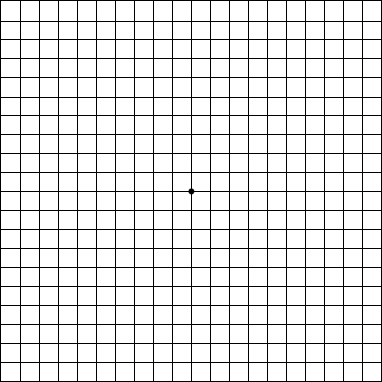 The main reason for blindness among the 50-year-olds and above in western countries is the degeneration of the macula lutea. This slowly progressive disease affects 115 000 people in Estonia alone.
The main reason for blindness among the 50-year-olds and above in western countries is the degeneration of the macula lutea. This slowly progressive disease affects 115 000 people in Estonia alone.
The yellow spot, or the macula, is an oval area as big as the head of a matchstick on the retina at the back of the eye and it is the most important spot in the eye for central visual acuity and differentiating colors.
The symptom of age-related macular degeneration (AMD) is slow, but gradual fading of detailed vision or a total loss of sight. It’s common for AMD that the viewing of objects is disturbed by a dark patch or blurry spots, which create a feeling, like when reading a newspaper, that some of the letters are missing.
The shape and the contour of objects are blurry and distorted: e.g. otherwise straight frames of windows or doors may seem bent.
What is Macular Degeneration?
Macular degeneration means atrophy of the macula lutea, otherwise called yellow spot. The macula enables to see fine details very clearly, and for an example, to read or to drive a car. If the yellow spot stops working properly, then the central vision could be weakened by obscurity, dark areas or distortions.
The degeneration of the yellow spot affects the ability to see closer and far, and could make some activities completely impossible, like to thread a needle or reading. Although AMD reduces vision in the central part of the retina, it does not affect the eye’s peripheral vision. E.g. you could see the contours of a watch, but you can’t see what time it is.
Macular degeneration alone does not cause total loss of sight. Even in advanced cases vision is preserved to some extent and very often the persons with this condition can take care of themselves. In many cases the affect of macular degeneration on vision quality is minimal.
What Causes Macular Degeneration?
Macular degeneration on older adults is part of the natural ageing process. There are many problems related with the yellow spot, but AMD is the most common. Its causes are not entirely known and there’s no treatment available to cure everyone. Macular degeneration is the main severe cause for loss of sight amongst Caucasians who are older than 65.
Two of the most common types of macular degeneration are atrophic (dry) and exudative (wet). The atrophic AMD is more common than exudative and it is caused by ageing and the loss of macular cells. The loss of vision is usually gradual.
The exudative AMD makes up 10% of most AMD cases and it is a result of abnormally formed blood vessels under the retina. These new blood vessels leak blood or liquid, which weakens central vision. Loss of sight can be rapid and severe.
What are the Symptoms of AMD?
Macular degeneration can result in different symptoms on different people. In its early stage the condition can be barely noticeable. Sometimes vision loss occurs only in one eye, and the other remains perfectly good for many years. If the degeneration affects both eyes, the loss of central vision is more easily perceived. Usually people notice vision loss when:
- Printed text appears blurry * A dark or an empty area appears in the middle of the visual field. * Straight lines are distorted.
How is AMD Diagnosed?
Many people are not aware of having AMD until the weakening of their vision becomes apparent. An ophthalmologist can observe early stages of AMD during a medical eye examination by performing the following tests:
- Simple vision screening, where you look at a squared paper resembling a table (Amsler Grid) * Examination of the macular with the ophthalmoscope * Special photography of the eye (fluorescence angiography) to find abnormal blood vessels under the retina
How is AMD Treated?
Although the reasons for AMD are not completely known, food supplements, like vitamins with anti-oxidant qualities and zinc, can prevent the progression of macular degeneration. An extensive scientific research proved that taking high doses of vitamin C and E, beta-carotene and zinc reduced the risk of developing advanced forms of AMD by 25%. However, test subjects, who didn’t have AMD or who had it in its early stage, had no clear benefit from food supplements.
The most common sign of macular degeneration is the formation of small deposits called drusen under the retina. The drusen alone do not cause visual loss, but if their number and size grows, it usually leads to an increased risk of developing AMD.
People with the predisposition for advanced AMD have noticeable drusen, prominent dry AMD or abnormal blood vessels under the macular in one eye (so called wet exudative AMD).
It’s very important to remember that neither can you treat AMD with vitamins nor can you restore your lost sight, though in some cases vitamins help to retain vision.
You could consult your ophthalmologist, if you are at risk and if you should take food supplements.
Clinical testing have proven that the sooner you start preventing macular degeneration, the bigger the odds of postponing the disease or to noticeably slow down its progress. Eating healthy, e.g. fresh vegetables and fish, surely has a role in reducing the risk of AMD.
Laser Surgery and Photodynamic Treatment
Certain forms of the exudative AMD can be treated with laser surgery which is done during an ambulatory procedure. In case of laser treatment or photodynamic therapy the leakage damaging the macula caused by blood vessels is slowed down or stopped with focused light rays.
These courses of treatment help to retain vision in a great extent, but they can’t make vision return normal. Despite enhanced medical treatments, a lot of people with AMD still experience some loss of vision.
An ophthalmologist can help patients adjust with weakened vision by assigning special optical devices or directing them to a specialist or a centre that deals with visual disability.
Since macular degeneration does not usually affect the periphery vision, one can continue doing its favorite activities, using optical devices to enhance vision, e.g. magnifying and TV-appliances or devices that talk or are connected to a computer.
Vision Test with Amsler Grid
You can check your vision by using Amsler Grid. With this you could observe changes in your vision which you would normally not notice.

Using the Amsler Grid
Put on your reading glasses and hold the grid in bright light at a distance of approximately 30-40 cm from the eyes.
Cover one eye.
Concentrate with your uncovered eye on the dot in the middle of the grid. Observe if all lines of the grid are straight or if some of the areas are distorted, darker or blurry.
Repeat with your other eye.
If a part of the grid is wavy, fuzzy or dark, make an appointment with your ophthalmologist immediately.
Article by Ants Haavel.









Join the Discussion
Type out your comment here:
You must be logged in to post a comment.